by Sandra Gulland | May 12, 2014 | Adventures of a Writing Life |
Some book clubs have book-themed dinners, but imaging a club whose members historically dressed for a discussion of a historical novel.
Then: imagine that they are discussing your book.
And now imagine that they are discussing your book in a bookstore.
You have to admit that that’s fairly special!
Historically dressed book club reads Mistress of the Sun
Tami Grondines, a Chapters/Indigo employee, reported to HarperCollins Canada that Mistress of the Sun, was “very well received” by her book club. It scored a “solid 9 out of 10.” (Yay! :-)
Here are photos of two of the members who historically dressed for the discussion!
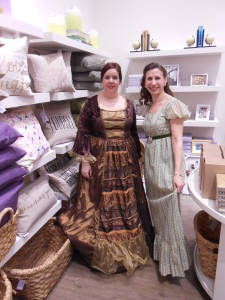
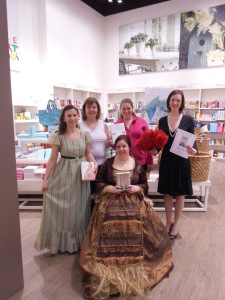
I love that there are three editions of Mistress of the Sun in the snapshot.
This book club is extra special to me because Tami, the organizer, gave me editorial feedback on an early draft of The Shadow Queen,
Here she is with published hardcover edition, pointing to her name in the acknowledgements.
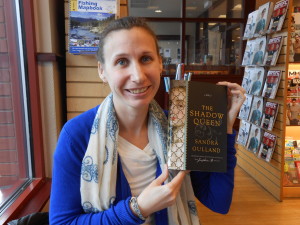
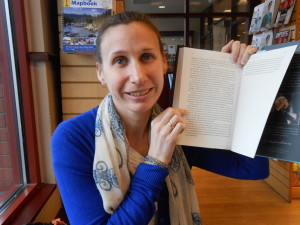
She wrote: “… seeing the changes that Sandra made due to my feedback was amazing and emotional.”
Thank you, Tami! Your feedback was important.
I have written an essay on this unusual editorial “experiment” asking bookstore employees to read an early draft of a manuscript. I will link to here as soon as it is up.
In the meantime, I hope you enjoy The Shadow Queen and Mistress of the Sun, the two novels in The Sun Court Duet, now both out in paperback.

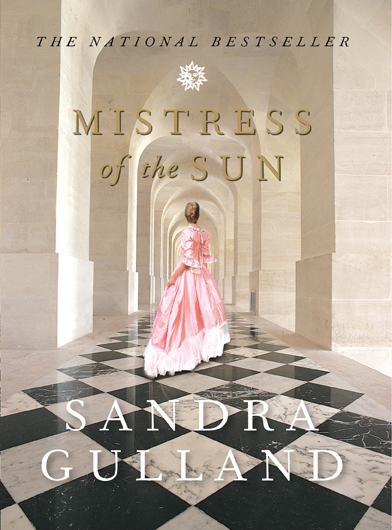
Here is a Pinterest blog on Book Inspired Costumes. Fun!
by Sandra Gulland | May 2, 2014 | Adventures of a Writing Life |
I’m going to be brief here, because I want to watch “Mad Men.” :-)
Too, I’ve been reading OVERWHELMED; Work, Love and Play When No One Has the Time by Brigid Schulte.
The cover says it all:

Leisure is important!
But before I escape into the worlds of Don and Betty, I want to say that I’ve returned to writing (gearing down from promotion-land), and it’s such a pleasure.
Also to mention that today was an excellent day for reviews of THE SHADOW QUEEN.
Reading an issue of Renaissance, I came upon a glowing review. It’s not on-line, but here’s the concluding sentence:
This book is a treasure for any lover of literary historical fiction.
The second is from the Pittsburg Examiner, which concluded:
The Shadow Queen will prove to be one of the top historical fiction novels in 2014 because of interesting characters, a unique story, and such attention to detail and research. This is a walk back in time you don’t want to miss!
Of course I’m smiling!
Now to the on-going saga of Don and Betty …
by Sandra Gulland | Apr 15, 2014 | Adventures of a Writing Life |
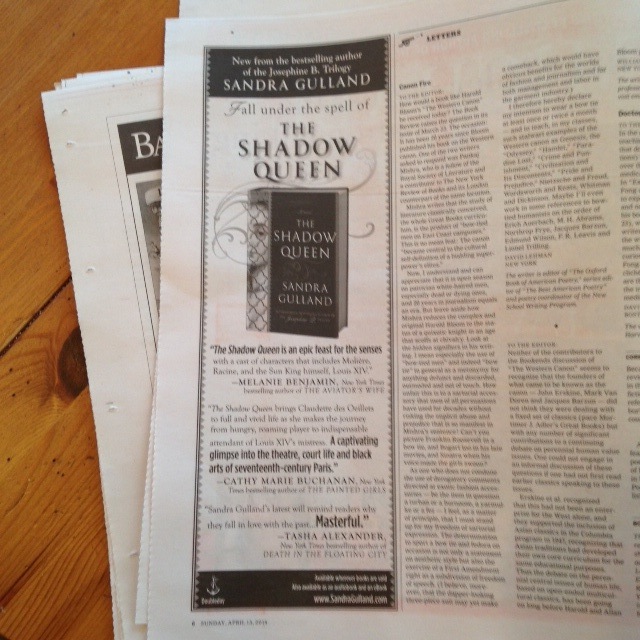
{Ad for The Shadow Queen in the New York Times Review of Books!}
Publication swirl: ups, downs, ups! A book tour entails a heady combination of fatigue and exhilaration. The challenge is not to come down with a cold. (Grrrrr.) Plus snow (!) today in Toronto, which I hope doesn’t affect the turnout at the reading tonight at A Novel Spot in Etobicoke.
My task today is to prepare for the talk/reading—my first full-on one. I never take this type of thing lightly. I think I have it basically plotted out, but I’ve not timed or honed it. That’s going to take time.
Plus, I need to get my talk printed out. This is surprisingly difficult on the road. I’m tempted to get a travel printer—but this would add to my already overly-bloated luggage.
Some guest blog posts I’ve written on my Blog Hop Tour:
Getting around to it—on why I became a writer, for Meg Waite Clayton’s blog.
Interview with Margaret Donsbach on HistoricalNovels.info. (Margaret asks great questions.)
The Page 69 Test: I love page 69 of The Shadow Queen. I plan to use this scene in my talk tonight.
What I’m reading now: Are you a Penelope Fitzgerald fan? I am!
I was pleased with this review from The Free-Lance Star: Real life characters inhabit intriguing story, which concludes: “A remarkably different and very interesting historical read.”
There have been some excellent reviews on Amazon.com that please me very much.
Highlights from the tour so far:
• The woman in North Vancouver who named her daughter Josephine after reading the Trilogy. She had a beautiful book her daughter had made a drawing in, and she asked me to sign the page opposite. I wish I had taken a photo.

• Moderator Jen Sookfong Lee at the “Enlivening the Past” panel in North Vancouver asking me if I’d brought my clown nose. (No, of course not—but it does make me wonder if I could pull off a reading wearing it. Doubtful!)
• Dinner in North Vancouver with writers Mary Novik and Roberta Rich. Shop-talk pals!
• The best highlight from tour so far: seeing my daughter and her wonderful family in Toronto. The wee-ones are growing!
by Sandra Gulland | Mar 24, 2014 | Adventures of a Writing Life |
Dramatic!
Clicking takes you to YouTube. Feel free to “Like” it!
If you click “Share this video” you will be able to share it on any of your Social Media sites, which I’d love for you to do. For the tech-minded among you, clicking “embed” gives you the code you need to put the video on your own blog.
I’m going to be getting out a newsletter in a few days, so if you’re not subscribed, you might want to get on the list. (Click here to sign up.) With each newsletter, a subscriber wins a book.
Another big change will be the redesign of this website … stay tuned!
And, for those of us who do not have access to the New York Times Book Review, here is the ad that will be in the April 13 issue. (Yes, I am thrilled.)
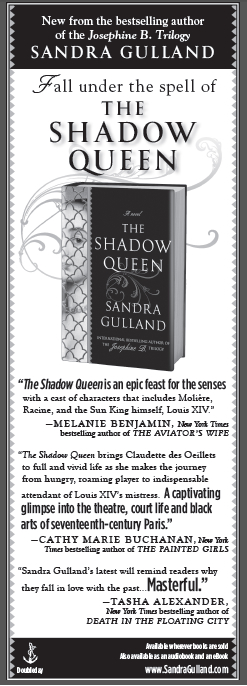
by Sandra Gulland | Mar 3, 2014 | Baroque Explorations |

The Bastille Archives are a treasure trove of information. This morning I discovered, for example, in a report by Reynie, the police chief, that the “love powders” being delivered by Voisin to Montespan—for use on the King (or perhaps by Montespan herself?)—contained “des cantharides,” more commonly known as “Spanish Fly.”
Ah. Love powders indeed.
Cantharidin powder was used in aphrodisiac sweets called pilles galantes, or pastilles de Richelieu, because the Duc de Richelieu offered them to his mistresses. In the 18th century, Madame du Barry, King XV’s mistress, was said to have called them pastilles de sérail (pastilles of the seraglio), taking them herself or giving them to young women to prepare them for amorous duty with the ageing King. In 19th century France, it was commonly available as philtre amoureux or love philtre. Sometimes the powder was dissolved in alcohol, producing a tincture.
“Before, she was common talk; now,
none dare say, cantharides can stir her.”
—1611, Beaumont
“Spanish Fly” is in fact neither Spanish nor a fly, but a “blister beetle” which has a chemical in its body that’s an irritant. When rubbed on the body it produces blisters (hence its name). When the dried, crushed body of the beetle is eaten, it causes inflammation of all the organs of the genital tract, including the genital organs. This gave rise to the believe that it was an aphrodisiac and could be used to treat impotence.
However, the swelling induced could be extremely painful, and the dose required to produce swelling was close to fatal. (A dose of only 10 milligrams can kill.) In women the powder could cause painful contractions of the uterus, and for this reason it was used to induce abortions.
It also caused a number of medical problems. It could cause permanent renal damage, for example (which casts suspicion, in my mind, on the King’s renal fistula later in his life). Over time, the kidneys would be damaged. The user (or, rather, abuser) would experience a dull, heavy pain in the loins, and have a constant desire to urinate (but passing only a small amount of blood-stained urine). After some time, convulsions occur followed by death within twenty-four hours.
The history of its use is long. The Roman empress Livia (58 B.C.-A.D. 29) slipped it into the food of members of the imperial family to cause them to commit sexual indiscretions that could later be used against them. In 1772, the Marquis de Sade gave sweet aniseed balls laced with Spanish Fly to prostitutes, who began to have uncontrollable vomiting, and died in agony a week later. In 1953, a fisherman accidently killed himself by pricking his thumb with a fish hook that had been dipped in a tincture containing the powder (which he believed would attract fish). The following year a man was convicted of killing two women by giving them coconut candies with cantharidin in them.
“You whoreson cantharides!” —1601, Ben Johnson
It had medical uses, as well. Cantharidin powder was believed to cure gout, carbuncles, rheumatism as well as a number of other medical disorders. Today it is used in the treatment of warts and in veterinary medicine in breeding farm animals.
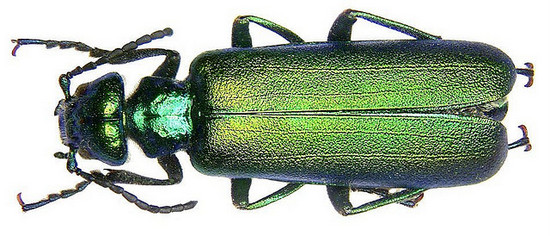
Blister beetles would have been easy to acquire. They often swarm within alfalfa fields, and most often in fields next to weedy areas that are likely to contain an abundance of grasshopper eggs, on which they feed. They also can be found clustered on an evergreen shrub used for hedges, or olive, ash or elder trees.
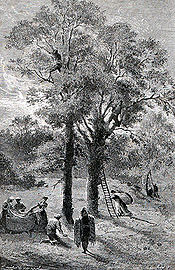
By tradition, the beetles were gathered before sunrise while unable to fly. The collectors veiled their faces and hands before shaking them down onto cloths laid out on the ground. The beetles were then dried, and heated until they disintegrated into a fine powder, which has a bight green metallic lustre.
When swallowed, a person would experience a burning sensation in the throat and stomach, have difficulty swallowing, experience nausea and abdominal pain, vomit blood-stained material, feel an intense thirst, and have diarrhoea with traces of blood and mucus. Sometimes blisters form on the mouth and parts of the intestine.
All in all: not very romantic!














